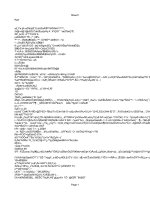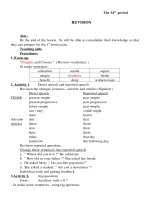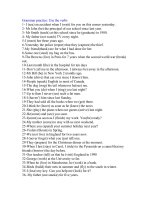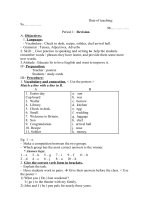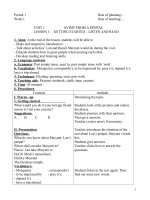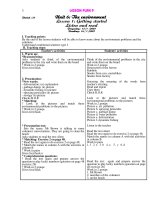giao an tieng anh 9 chuan 2010
Bạn đang xem bản rút gọn của tài liệu. Xem và tải ngay bản đầy đủ của tài liệu tại đây (285.85 KB, 69 trang )
٭٭٭ Giáo viên : Chung Th ị Đ ạ o ٭٭٭
Tiết : 1 Date : 17/08/2009
REVISION AND INTRODUCTION
Aim: Helping the students to remind what they have learnt in English 8 and
what they are going to learn in English 9.
Objective: By the end of the lesson students will be able to remember what
they have learnt in English 8 and know what they are going to learn in
English 9.
Teaching aids: textbook
Procedure:
Stage Steps/ Activities Work
arrangement
Warm up
Revision
Introduction
Homework
• Chatting:
-How are you today?
-Do you like the weather today?
-Did you enjoy your summer vacation?
-What did you do?
-Where did you go?
...etc.
-Ask students to call out what they have
learnt in English 8.
- The present simple
-Reflexive pronoun
-Reported speech
-Gerund
- The present perfect
-The passive
--ed and –ing participles
-Sequence markers
-Ask students to look at their English 9 and
answer some questions
How many units are there?
What are there in each unit?
....etc.
-Teacher introduces how many periods are
there in each week,how to learn English 9
effectively,what to do after each period,......
-Ask students to prepare for the next lesson.
Teacher
whole class
Teacher
whole class
Teacher
whole class
Individual
work
1
٭٭٭ Giáo viên : Chung Th ị Đ ạ o ٭٭٭
Tiết : 2 Date : 18/08/2009
UNIT 1: AVISIT FROM A PEN PAL
LESSON 1:Getting started- Listen and read
Aim: Reading for details
Objective: By the end of the lesson,the students will be able to know about
some places Lan went to with a foreign friend and some activities they took
part in together.
Teaching aids: Textbook, pictures
Procedure:
Stage Steps/ Activities Work
arrangement
Warm up
Pre reading
While
reading
Chatting:-do you have any pen pal?
Where does s/he live?
Has s/he visited your country?
What activities would you do during the
visit?
Possible answers:
Temples-theaters
-restaurants
Churches-beaches-
mountains
Pre teach: to correspond(exp)
A mosque (pic)
To pray ( mime)
Checking vocab R O R
Open prediction
Lan’s pen pal came to visited her in
Hanoi.Can you guess where she went and
what she did during her stay?
T-whole class
Whole class
Pair work
Whole class
2
٭٭٭ Giáo viên : Chung Th ị Đ ạ o ٭٭٭
Post reading
Homework
Ask students to read the text to check their
prediction.
Ask students to read the text again to
choose the correct option to complete the
sentences on page 7.
Answer:
1.Lan and Maryam usually write to each
other every two weeks.
2.Maryam was impressed because Hanoi
people were friendly.
3.The girls went to see famous places in
Hanoi,areas for recreation,a place of
worship.
4.Maryam wanted to invited Lan to Kuala
Lumpur.
-Speaking:
-Ask students to recommend places of
interest in their city.
-Ask them to discuss where they should
take their friends to and what activities
they should do.
Cues:
-LangCo Beach- swimming/beach
in Hue
-BachMa National Park- mountain
climbing
-LinhMu Pagoda, TuDuc Tomp-
sighting/beautiful sight.
Using the patterns
S1: I think we should take our friends to
DongBa Market. We can do shopping or
I’ll just introduce them a Vietnamese
market.
S2:Good idea .I bilieve they will be
interested in it.
Individual
work
Individual
work
3
٭٭٭ Giáo viên : Chung Th ị Đ ạ o ٭٭٭
-Ask students to write a short paragraph
about what they have just discussed with
their partner
Tiết : 3 Date : 22/08/2009
Unit 1: A VISIT FROM A PEN PAL
Lesson 2-Speak
Aims: Make and respond to introductions
Objectives:By the end of the lesson students will be able to make and
respond to introductions
Teaching aids: textbook ,pictures
Procedure:
Stage Steps/Activities Work
arrangement
Warm up
Activities 1
Pelmanism
Tokyo Perth Liverpool Bombay Hoi An
Japan Australia England India Vietnam
Teacher introduces the situation-Nga is talking
to Maryam.They are waiting for Lan outside
the school.
-Ask students to do exercise a) on page 8.The
students have to work in pairs to put the
sentences in the correct order to make a
complete dialogue,
Answer:
1.Hello.You must be Maryam.
c-That’s right , I am.
5.Please to meet you.Let’s me introduce
myself,
I’m Nga.
Group work
Teacher-
class
Pair work
4
٭٭٭ Giáo viên : Chung Th ị Đ ạ o ٭٭٭
Activity 2
Home work
b)Pleased to meet you, Nga. Are you one of
Lan’s classmates?
4.Yes,I am. Are you enjoying your stay in
Vietnam?
d)Oh ,yes very much .Vietnamese people are
very friendly and Hanoi is a very interesting
city.
2.Do you live in a city, too?
e)Yes, I live in Kuala Lumpur. Have you been
there?
3.No.Is it very different from Hanoi?
.a)The two cities are the same in some ways.
6.Oh, I see. Here’s Lan . Let’s go.
Ask some questions to check
-Have Lan and Maryam met each other
before?
-Is Maryam enjoying her stay in Vietnam?
-What does she like in Vietnam?
Students practice the dialogue
*Role play
-Set the scene:You are talking to Maryam’s
friends, introduce yourself.
-Ask students to work in pairs to practice the
dialogue.
-Teacher goes round ,takes notesto correct
later
Ask students to write one dialogue they like
into their notebook.
T-class
Pair work
Tiết : 4 Date : 22/08/2009
UNIT 1: A VISIT FROM A PEN PAL
Lesson 3: -Listen
-Language focus:the past simple--wish
Aim: Listen for specific information and further practice in past simple with
wish and past simple.
5
٭٭٭ Giáo viên : Chung Th ị Đ ạ o ٭٭٭
Objective: By the end of the lesson students will be able to listen to specific
information to select the correct pictures and to use past simple and past
simple with wish.
Teaching aids: textbook,pictures, cassette
Procedure:
Stages Steps /Activities Work
arrangement
Warm up
Pre
listening
While
listening
Post
listening
• Jumped words:
Tccah = catch
Rkap = park
Ondp = pond
Rssag = grass
Rrubhmage = hamburger
-Set the scence”Tim John’s Mexican pen
pal,Carlos is visiting the USA’
-Ask students to look at the pictures and tell
the class what there is in each one ,where the
place is,what the people are doing.
-Open prediction;S.think of 3 things that Tim
and Carlos are doing
P.Answers: *going to the park *taking a bus
*going to the park
-Ask students to listen to the tape to check
their guesses.
-Give feedback.
-Ask students to listen to the tape 2
nd
time to
choose the correc pictures
Answer: a.1 b.2 c.2
The past simple
-Form: VERB-ED/V2
-Meaning: da
-Ask students to work in pairs to ask and
answer questions about what Ba, Nga, Lan,
Nam and Hoa did on the weekend(ex.1 p.11)
Possible conversations:
1.A. What did Nga do on the weekend?
B. She went to the concert performed by
Hanoi singers
A. When did she go?
Group work
T-whole
class
Individual
work
Pair work
6
٭٭٭ Giáo viên : Chung Th ị Đ ạ o ٭٭٭
Homework
B. She went there on Saturday at 8 pm.
2.A. What did Lan do on the weekend?
B. She went camping held by Y&Y.
A. When did she go?
B. She went camping all the weekend .She
went on Saturday morning.
Set the scence : Lan and her friends are
holding a farewell party for Mary am .Write
the things they did to prepare for the party”
-Ask students to use the words and the
pictures in the box.
1. Hoa baked the cake.
2. Hai hung colorful lamps on the wall.
3. Hanh bought flowers.
4. Tan painted a picture of Hanoi.
5. Nga and My went shopping.
The past simple with WISH
-WISH is used when we want really to be
different and exactly opposite of the truth, eg :
express wishes in the present.
Form: S+ wish + S+ Past Simple
-Ask students to look at the real situations and
make wishes.
*Sample answers:
b.I wish I were in the swimming pool now.
c……….. had a computer now.
d………..lived close to school.
e…………had a sister.
f…………drew well.
g…………had my friend’s phone number.
h…………knew many friends
Ask students to make 5 wishes of their own.
T-Whole
class
Individual
work
Tiết : 5 Date : 23/08/2009
UNIT 1:A VISIT FROM A PEN PAL
Lesson 4: Read
Aim: Reading for details
Objective: By the end of the lesson, students will have some knowledge
about Malaysia, one of the countries of the ASEAN.
7
٭٭٭ Giáo viên : Chung Th ị Đ ạ o ٭٭٭
Teaching aid: textbook, pictures , map of countries of the ASEAN
Procedure:
Stage Steps/Activities Work
arrangement
Warm up
Pre reading
While
reading
*Hangman
-The word has -------- letters. It is
MALAYSIA
-Ask students what they know about Malaysia.
-Ask them to make questions for what they
want to know.
Expected questions:
Where is it?
What is the capital of Malaysia?
What is its population?
How big is Malaysia?
What language is spoken in this country?
-Ask students to read the text to find out the
answers to their questions.
-Teacher gives feedback to the class.
-Ask students to read the text the 2
nd
time to
fill in the chart in exercise a) on page 10.
*Answers:
1.329,758
2.Over 22 million
3.Tropical climate
4.The ringgit-consist of 100 cent
5.Kuala Lumpur
6.Islam
7.Bahasa Malaysia
8.English
-Ask students to read the text again to do the
True or False statements.
*Answers:
1.T.
2.F.-There are more than two regions.
T-whole
class
Whole class
Individual/
Pair work
Pair work
8
٭٭٭ Giáo viên : Chung Th ị Đ ạ o ٭٭٭
Post
reading
Homework
3.F.-English,Chinese,and Tamil are widely
spoken.
4.F.-One of the three : Malay , Chinese ,Tamil
5.F.-English is a compulsory second
language ,not primary language of instruction.
-Ask students to answer the questions in front
of the class.
-Teacher gives feedback to the whole class.
* Interview:
-Ask students to work in pairs
-Give students their task
A: You are going to visit Malaysia Prepare
some questions to ask Mary am about her
country
B: You are Mary am from Malaysia .You have
to answer A’s questions.
*P.A:
A. Hi, Mary am . I’m going to visit Malaysia.
I’d like to know something about your
country. Can you help me?
B.Yes , certainly.
A.What language is spoken in your country?
B.Bahasa Malasia, English, Chinese, and
Tamil are widely spoken.
A.Do children have to study any foreign
language in school?
B.Yes,English is a compulsory second
language in secondary school.
A. Ah, I see. What about the people? What are
they like?
B.I think they are friendly….
Write a paragraph to introduce your city as a
tourist attraction.
Pair work
Individual
work
Tiết : 6 Date : 28/08/2009
UNIT 1: A VISIT FROM A PEN PAL
Lesson 5:Write
9
٭٭٭ Giáo viên : Chung Th ị Đ ạ o ٭٭٭
Aim: Writing a personal letter.
Objective: By the end of the lesson,students will be able to write a personal
letter..
Teaching aids: textbook
Procedure:
Stage Steps/Activities Work
arrangement
Warm up
Pre-writing
*Chatting:
-Have you ever visited any other places in
Viet Nam?
-When did you go?
-How did you get there ?
-Did you visit any places of interested ?
-Did you buy any thing?
-When you are away from home , do you keep
in touch ? How ?
-Set the scine : Imagine you are visiting your
relatives or friends in another part of Viet
Nam or a different country.
-Ask students on their own answer the
following questions:
1. Where are you now?
2. How did you get there?
3. Who did you meet?
4. What have you done?
-What places have you visited?
-Who have you met?
-What kind of food have you tried?
-What souvenirs have you bought?
5. How do you feel now?
6. What do you think interest you most?
7. When are you returning home?
-Ask two or three students to tell the class
about their visit.
-Ask students to work in pairs to talk to each
other about their visit.
-Remind students about the format of a
personal letter by asking the question:What
are the parts of a personal letter?
T-whole
class
Individual
work
Individual
work
T-whole
class
10
٭٭٭ Giáo viên : Chung Th ị Đ ạ o ٭٭٭
While-
writing
Post-
writing
Homework
A.Heading-Writer’s address and the date
B.Opening-Dear….
C.Body of the letter
D.Closing-Your friend/Regard/Love
-Ask students to write a letter to their
family,telling them about their visit.
-Ask students to look at the outline on p.11
and ask them what part of the letter they are
going to write.
-Ask them to follow the outline to write their
own letter.
-Ask them to swap their letters,compare with
their partner’s,and correct if they can.
-Suggested ideas:
1
st
paragraph:
I arrived at Da Nang airport/station…at
2pm/8am…./late in the afternoon/….on
Tuesday/…….
Hoa/aunt Huong/..met me at the station/…then
he/she took me home by taxi/………..
2
nd
par
I have been to many places like the beaches,
……etc.I have tried different
foods:seafood,Da Nang speciality…I will visit
Hoi An and My Son tomorrow….
3
rd
par.
I fell so happy and enjoy myself so much.The
people here are so nice ,the foods are so
delicious ,and the sights are so beautiful.
I will leave Da Nang at 3am/…next Thursday/
….and will arrive home at 5am.Please pick me
up at the station/ ….
*Correction:
Choose some letters to correct in class(using
projector if possible)
Ask students to write their letters(after
correction) on their notebooks
Individual
work
T-whole
class
Individually
Tiết : 7 Date : 29/08/2009
11
٭٭٭ Giáo viên : Chung Th ị Đ ạ o ٭٭٭
UNIT 2:CLOTHING
Lesson 1:Getting started
Listen and read
Aim: Reading for details.
Objective: By the end of the lesson, students will know some more about ao
dai ,the traditional dress of Vietnamese women.
Teaching aids: textbook, pictures
Procedure:
Stage Steps/Activities Work
arrangement
Warm-up
Pre-reading
*Quiz:
-Divide class in to groups. Ask students to
look at the clothes people are wearing and take
turn to decide where each person comes from.
-Ex:
T: Where does the woman in picture a) come
from?
S1:She comes from Japan.
T: How do you know she comes from Japan?
S1:Because she is wearing a Kimono.
-The group who gives the correct answer gets
a point.
*Answer:
a. She comes from Japan.
b. She comes from Viet Nam.
c. He comes from Scotland(UK) (He is
wearing a kilt.)
d. She comes from India.(She is wearing a
sari.)
e. He comes from the USA.(He is wearing
jeans.)
f. She comes from Saudi Arabia.(She is
wearing a veil)
1.Pre teach vocabulary
-a poet( example :To Huu , Huy Can,…
are….)
-a long silk tunic (translation)
Group work
T-whole
class
12
٭٭٭ Giáo viên : Chung Th ị Đ ạ o ٭٭٭
While-
reading
Post-
reading
Homework
-to slit(translation)
-inspiration: (translation)
To take inspiration from:
-ethnic minorities(example:Thai,Muong,Ede,
…are…)
-a pattern(picture)
Checking vocab: R O R
*Set the scene:You are going to read atext
about the traditional dress of Viet Nam.
-Ask students toread the text to do exercise a).
-Give feedback.
Answer:
1.For a long time the Ao dai has been the
subject of poems,novels and songs.
2.The Ao dai is described as a long silt tunic
with slits up the sides worn over loose pants.
3.They prefer to wear modern clothing at
work.
4….by printing lines of poetry on it.
5.Another alternative is to add symbols such
as suns,stars crosses and stripes.
-Ask students to read the text again to answer
the questions.
1.Traditionally,men and women used to wear
the Ao dai.
2.Because it is more convenient.
3.They have printed lines of poetry on it or
have added symbols such as
sun,stars,crosses,and stripesto the Ao dai.
*Speaking:
Ask students to use their own words to tell the
group wha they have known about the Ao dai.
*Writing:
-Ask students to write down what they have
spoken to their partner and adding their
opinion whether they like wearing Ao dai or
not.
Pair work
Group work
Individual
work
13
٭٭٭ Giáo viên : Chung Th ị Đ ạ o ٭٭٭
Tiết : 8 Date : 05/09/2009
Unit 2:CLOTHING
Lesson 2-Speak
Aim: To ask and respond to questions on personal references.
Objective: By the end of the lesson students will be able to ask and respond
to questions on personal references
Teaching aids: textbook ,pictures
Procedure:
Stage Steps/Activities Work
arrangement
Warm-up
Activity 1
Activity 2
*Revision: Words refered to clothes
-sweater -jeans -skirt
-striped
-baggy -plain -blouse -suit
-plaid -shorts -pants -shirt
-Ask students to look at the pictures and match
them with the phrases.
a. a colorful T-shirt
b. a sleeveless sweater
c. a striped shirt
d. a plain suit
e. faded jeans
f. a short –sleeved blouse
g. a baggy pants
h. a plaid skirt
i. blue shorts
Check the vocabulary: Kim’s game
-Ask students to remember the phrases on page
14,15 in 30s then let their book closed .
-Divide the class into 4 groups.
-Students from each group take turn to go to the
blackboard write as many words as they can.
-Group with the most words win the game
-Ask students to work in groups of 8 or 10
students each to read and write two more
questions for the last section of the survey about
student’s wear.
T-whole
class/
Team work
Pair work
Group work
Group work
14
٭٭٭ Giáo viên : Chung Th ị Đ ạ o ٭٭٭
Activity 3
Homework
-The form of the survey may look like this:
Questions Name Items
of
clothes
Notes
1. What do you
usually wear on the
weekend?
2. Why do you wear
these clothes?
3.What is your
favorite type of
clothing? Why ?
4.Is it comfortable to
wear uniform?
5.What color is it?
6.What type of
clothing do you
usually wear on Tet
holiday?
7.What would you
wear to a party?
-Ask students to interview their friends .
-After students have finished their task ask them
to report the result of their survey in their group.
The survey should begin as follow:
Three people said that they liked their uniform.
Two people said that they usually wore colorful
T-shirt on the weekend.
Chi said she loved baggy pants.
Ask the representative from each group to
present the result of the survey in front of the
class.
Ask students to make a list of types of clothing
that most of the students in the class like
wearing on different special cases.
Group work
Individual
work
15
٭٭٭ Giáo viên : Chung Th ị Đ ạ o ٭٭٭
Tiết : 9 Date : 06/09/2009
UNIT 2: CLOTHING
Lesson 3: Listen- Language focus 1
Aim: Listen for specific information and further practice in the present
perfect with FOR or SINCE.
16
٭٭٭ Giáo viên : Chung Th ị Đ ạ o ٭٭٭
Objective: By the end of the lesson students will be able to listen to specific
information, describe what people are wearing and know how use the
present perfect.
Teaching aids: text book , pictures, cassette
Procedure:
Stages Steps /Activities Work
arrangement
Warm up
Pre-
listening
While-
listening
*Revision:
Two team write words relating to CLOTHING
The team which write more words in limited
time is the winner.
-Ask students to look at the pictures on p.16
and answer the questions :
+What are these?
+What is this?
+ What color is this?
+ What color are these?
Pre –teach vocabulary
Announcement (translation)
Missing (synonym of lost)
An entrance (synonym of a door, gate)
Fair (translation)
A doll (realia)
Checking vocab : Slap the board
*Set the scene: You will hear an
announcement about a lost little girl called
Mary.
-Ask students to listen and answer the
questions:
1.How old is she?-She is 3.
2.Where was she last seen? -She was last
seen near the main entrance to the Car Fair.
3What’s she like? -.She has short dark hair.
-Ask students to listen and check.
Team work
T-whole
class
Individual
17
٭٭٭ Giáo viên : Chung Th ị Đ ạ o ٭٭٭
Post-
listening
Home work
a) B b) A c) C
*Speaking:
-Ask students to describe a friend of theirs,
answering the questions:
How old is she/he?
What is she/he like?
What type of clothing does she/he like
wearing?
What is she/he wearing today?
*Presenting structure:
-Ask students to look at the dialogue on p.19
-Elicit from students:
-The present perfect is used to talk about
something which started in the past and
continues up to the present.
-We often use FOR and SINCE with the
present perfect tense.
FOR + a period of time
SINCE + a point of time
*Practice:
-Ask students to use the information in the
table on p.20 to make similar dialogues. Then
practice with their partner.
-Teacher goes round the class ,taking notes to
helf correct S’s pronunciation.
-Ask students to write in their notebook what
they have described to their friends about one
of their friends and the conversation b) and c)
The whole
class
Pair work
Individual
work
Tiết : 10 Date : 13/09/2009
UNIT 2: CLOTHING
Lesson 4: Read
Aim: To read the text for details.
18
٭٭٭ Giáo viên : Chung Th ị Đ ạ o ٭٭٭
Objective: By the end of the lesson, students will be able to understand the
text for details ,about jeans.
Teaching aids: textbook, pictures
Procedure:
Warm up
Pre-reading
While-
reading
*Shark’s attack:
_ _ _ _ _ JEANS
Pre-teach vocabulary:
-material (translation)
-cotton (realia)
-to wear out (translation)
-a style (realia)
-to embroider (realia)
-a label (realia)
*Checking vocab: What and where
Brainstoming:
-Ask students the question:What do you
want to know about jeans?Make questions
-Elicit qs from students:
Who first designed jeans?
When did jeans become popular?
Where were jeans made?
What were jeans made of?
What are some famous jeans designers?
- Ask students to read the text to find out the
answers to their questions and add more
ideas.
-Ask students to read the text to fill in the
missing dates and words.
*Answers:
1.18
th
century............................jean cloth.
Teacher-whole
class
Teacher-whole
class
Pair work
Individual work
Stage Steps/Activities Work
arrangement
19
٭٭٭ Giáo viên : Chung Th ị Đ ạ o ٭٭٭
Post-
reading
Homework
2.1960s.............................students
3.1970s..........................cheaper.
4.1980s..........................fashion.
5.1990...........................sale.
-Have students work in pairs to answer the
questions b. page 17.
-Give feedback
*Answers:
1.The word jeans comes from a kind of
material that was made in Europe.
2.The 60’s fashions were embroidered
jeans,painted jeans and so on.
3.Because jeans became cheaper.
4.Jeans at last became high fashion clothing
in the 1980s.
5.The sale of jeans stopped growing because
the worldwide economic situation got worse
in the 1990.
*Discussion:
-Have students work in groups to discuss the
questions.
1.Do you like wearing jeans? Why?/Why
not?
2.What type of jeans do you love wearing?
3.Do you think jeans are in fashion?
-Ask students to write down what they have
talked about in groups in their notebooks.
Pair work
Group work
Individual work
Tiết : 11 Date : 14/09/2009
UNIT 2: CLOTHING
Lesson 5: Write
Aim: Writing an exposition.
Objective: By the end of the lesson, students will be able to write an
exposition.
20
٭٭٭ Giáo viên : Chung Th ị Đ ạ o ٭٭٭
Teaching aid: textbook
Procedure:
21
٭٭٭ Giáo viên : Chung Th ị Đ ạ o ٭٭٭
Stage Steps/Activities Work
arrangement
Warm up
Pre-writing
*Chatting:
-Ask students some questions:
How often do you wear uniforms?
How do you feel when you wear uniforms?
If you have a choice, what type of clothing
do you want to wear when you go to school?
Why do you choose it?
1.Pre-teach vocabulary:
-to encourage (explanation )
-to be equal in (explanation )
-to bear one’s name (picture )
-freedom of choice ( translation )
-self-confident ( translation )
*Checking vocabulary: R O R
2.Presentation:
-Stick the outline of an argument on the board
.
Lets the readers know the writer’s point of
view
Present argument in a logical way-one in
each paragraph
Give examples where possible
Sum up the argument
My option is…..
I think……..
Firstly,…..
Secondly,…………
Finally,……….
Therefore,…….
In conclusion,…..
-Group with more strips filling in the table
with correct content is the winner.
-Ask students some qs:
What do you write in “introduction” ?What
language is used?
How can we present series of arguments ?
What language is used?
What do you write in conclusion?
-Ask students some comprehension qs:
What is the topic of the passage?
Why does wearing uniforms encourage
students to be proud of their school?
How do students feel when wearing
uniforms?
Do they have to think of what to wear every
T-whole
class
T-whole
class
Whole class
Team work
Individual
work
Pair work
22
٭٭٭ Giáo viên : Chung Th ị Đ ạ o ٭٭٭
Tiết : 12 Date : 15/08/2009
UNIT 2: CLOTHING
Lesson 6: Language focus.
Aim: Practice ALREADY and YET in the present perfect tense, distinguish
the difference in using the past simple and the present perfect tense.
Review the passive forms of the present perfect, simple present, simple
past, and simple future
Practice passive modal auxiliaries.
Objective:
By the end of the lesson, students will be able to use ALREADY and
YET in the present perfect tense, distinguish the difference in using the past
simple and the present perfect tense, and be able to use the passive forms of
the present perfect, simple present, simple past, and simple future ;practice
passive modal auxiliaries
Teaching aids: textbook
Procedure:
Warm up
Presentation
* Pelmanism :
do visited went go saw
see ate did visit eat
A. The present perfect
I. The present perfect with ALREADY& YET
-Set the scene:
-I have seen Giac Lam Pagoda.
-I have eaten Chinese and French food.
-Ask students to look at the dialogue.
A: Have you seen Giac Lam Pagoda yet?
T-whole
class
T-whole
class
Stage Steps/Activities Work
arrangeme
nt
23
٭٭٭ Giáo viên : Chung Th ị Đ ạ o ٭٭٭
Practice
B: Yes, I’ve already seen it.
A: Have you eaten Vietnamese food yet?
B: No, I haven’t.
*already is used in affirmative sentences
Position: midsentence
*yet is used in negative sentences and
questions.
Position: end of the sentence.
-Ask students to practice in pairs
-Teacher goes round, monitors and helps
II. The present perfect with EVER
-Teacher sets the scene, ask students to look at
the dialogue and elicit from them:
+We use the past simple to talk about definite
past time.
+We use the present perfect to talk about
indefinite past time.
eg: Have you ever been to Italy?
*EVER is used in questions.
A: Have you ever read a comic?
B: Yes, I have.
A: When did you last read one?
B: This morning.
B.THE PASSIVE
I. The passive form of the present perfect,
simple present, simple past, and simple future.
BE + PAST PARTICIPLE
-Ask students to do the exercise correctly.
II The passive form of modal verb sand the
verb patterns have to/be going to.
*Form:
Modal verbs + be + past participle
have to/be going to + be + past participle.
-Ask students to do exercise 5 on page 21.
Ask students to complete the sentences, using
the passive.
1.Have you ever......................
2.A new road.............................
Pair work
T-whole
class
Pair work
Individual
work
24
٭٭٭ Giáo viên : Chung Th ị Đ ạ o ٭٭٭
Homework
3.You can...................................
4.A party is going to...................
5.The Spring Fair..................................
-Ask students to copy the sentences into their
notebook.
Individual
work
25
